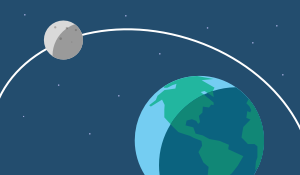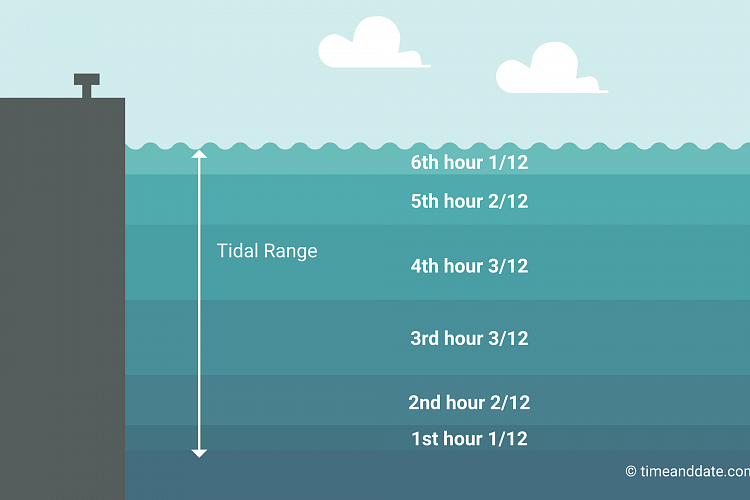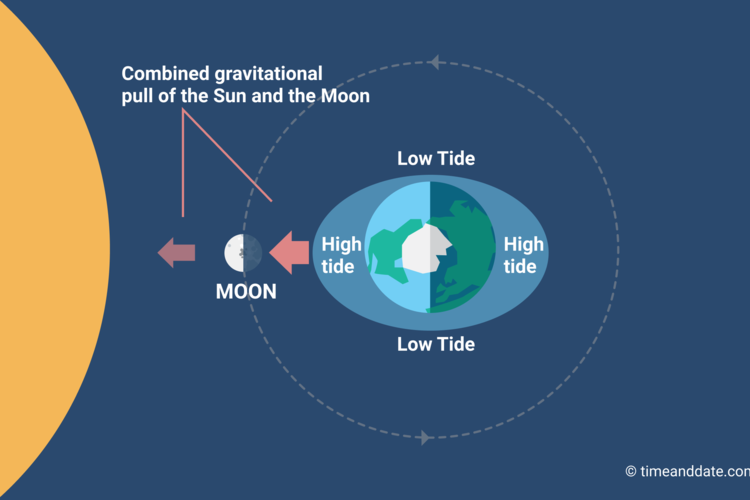 |
Moon phases visualized in real time, the past or the future. |
Time and Date AS
 |
| The water level changes gradually. |
Illustration showing how the gravitational force
of the Sun and Moon act together and create spring tides at New Moon and Full
Moon.
While both the Moon and the Sun influence the
ocean tides, the Moon plays the biggest role because it is so much closer to
our planet than the Sun.
In fact, the tidal effect of the Moon on Earth
is more than twice as strong as that of the Sun, even though the Sun's
gravitational pull on Earth is around 178 times stronger than that of the Moon.
Oceans Are Pulled Up
The gravitational force of the Moon and the Sun
pulls the water in the oceans upwards making the oceans bulge, which creates
high tide in the areas of Earth facing the Moon and on the opposite side. (See
illustration.)
At the same time, in other parts of the planet,
the ocean water drains away to fill these bulges, creating low tides.
However, the oceans' water is also constrained
by the continents and varying ocean depths.
As a result, the tides behave more like water sloshing
around in an oddly shaped bathtub than in a smooth and even basin.
High and Low Nearly Twice a Day
Tides are one of the most reliable phenomena in
the world, and we know that they move in and out around twice a day, but not
exactly. So, why is that?
A day on Earth is the time it takes our planet
to spin once around its own axis and return to the same point under the Sun.
This is known as a solar day, and it lasts around 24 hours.
However, the time it takes Earth to reach the
same position in relation to the Moon, takes, on average, 24 hours and 50
minutes, known as a lunar day.
The reason the lunar day is longer than a solar
day is that the Moon revolves around Earth in the same direction as Earth
rotates around its axis, so it takes Earth, on average, an additional 50
minutes to “catch up” to the Moon.
Because the tidal force of the Moon is more than
twice as strong as the Sun's, the tides follow the lunar day, not the solar
day.
It takes half a lunar day, on average 12 hours
and 25 minutes, from one high tide to the next, so we have high and low tides
nearly twice a day.
According to the National Ocean Service, there
are some exceptions to the main rule of 2 tides every lunar day: there are a
few places, for instance along the coastline of the Gulf of Mexico, where there
is only 1 tide per day.
This is caused by the local shoreline
topography, among other things. This tidal cycle is called a diurnal cycle, as
opposed to the normal semidiurnal cycle, where diurnal means daily and semi
means half.
Gradual Ebb and Flow
The change from low to high tide is known
as flood tide, while the change from high to low tide is
called ebb tide.
The technical term for the difference in water
level between high tide and low tide is tidal range.
The flow and ebb are gradual, so it is not
accurate to say that a high or low tide lasts around 6 hours and 12 minutes,
i.e. a quarter of a lunar day.
The speed of the water flow varies during this
period, and it also varies from place to place.
The Rule of 12ths
People who have to take the tides into account
in their daily life, like sailors, fishermen, and surfers, often use what is
called the rule of 12ths to calculate the expected water level.
This rule states that in the 1st hour after low
tide the water level will rise by 1/12 of the predicted tidal range in any
given area.
In the 2nd hour, it will rise 2/12, and in the
3rd hour, it will rise 3/12.
In the 4th hour, it will also rise 3/12, in the
5th, it will rise 2/12, and in the 6th hour, it will rise 1/12.
The sequence to remember is 1-2-3-3-2-1.
So, let’s say the predicted tidal range is 12
feet. In the 1st hour, the tide would rise 1 foot. In the 2nd hour, it would
rise 2 feet. In the 3rd and 4th hours, it would rise 3 feet. In the 5th hour,
the tide would rise 2 feet, and in the 6th hour, 1 foot.
Storm Tides and Surge
The astronomical forces which drive the tides
can be predicted very accurately, and these predictions are published in local
tidal tables.
However, different weather conditions also
affect the sea level and may cause both lower and higher tides than expected.
If there is a storm, the seawater level often
increases. This is called a storm tide and is caused by
a combination of storm surge and normal tidal movement.
Strong offshore winds can move water away from
coastlines, exaggerating the low tide, while onshore winds may cause the water
to pile up onto the shoreline, making the low tide higher than normal.
High pressure weather systems can lead to days
with exceptionally low tides, while low pressure systems may contribute to
causing much higher tides than predicted.
Geography and Topography Important
The depth and shape of the ocean and the
distance between continents are also important in determining the water level
along the shores.
In the northern parts of North America, Europe,
and Asia, the continents are close together, which creates a bigger difference
between high and low tides than in areas farther south, where the continents
are farther apart.
Average and Extreme Tides
The average tidal range in mid-ocean is around 1
meter or 3 feet. However, in some coastal areas, the tidal range can be more
than 10 times higher in the most extreme areas.
To give an average for tidal range along the
world's coastlines doesn't make much sense, as they vary so much from place to
place.
The world's highest tide is in the Bay of Fundy
in Canada, where the difference between low and high tide can be up to 16.3
meters (53.5 feet).
The highest tides in the US can reach 12.2
meters (40 feet) near Anchorage, Alaska. Along the coast of the UK, the tidal
range varies from as little as 0.5 meters (1.6 feet) to a maximum of 15 meters
(50 feet).
Spring Tides
The Moon’s phase also plays a part in the tidal
range. The greatest difference between high and low tide is around New Moon and
Full Moon.
During these Moon phases, the solar tide
coincides with the lunar tide because the Sun and the Moon are aligned with
Earth, and their gravitational forces combine to pull the ocean’s water in the
same direction.
These tides are known as spring tides or king
tides. The name has nothing to do with the season spring, but rather it
is a synonym for jump or leap.
If a spring tide coincides with either the March
equinox or the September equinox, it is called an equinoctial spring
tide.
At these times we can expect the largest tidal
range of the year because, at the equinoxes, the Moon and Sun are aligned with
the equator.
Several times a year, the Full Moon or New Moon
happens as the Moon is around its closest point to Earth, called perigee.
This is popularly known as a Supermoon and
leads to even larger variation between high and low tides, known as perigean
spring tides.
However, the difference from a normal spring
tide is only around 5 cm or 2 inches.
The opposite happens when the Full or New Moon
is around its farthest from Earth, apogee, also known
as Micromoon.
The apogean spring tides are
around 5 cm (2 inches) smaller than regular spring tides.
The tidal range is smallest around the 2 Quarter
Moons (Half Moons) because the gravitational force from the Moon and the Sun
counteract each other at these 2 points of the lunar month.
These tides are called neap tides or neaps,
from Anglo-Saxon, meaning without the power. Neaps always occur about 7 days
after spring tides.
Oceans and Some Rivers
There is a difference between having noticeable
tides and having true tides. For tides to be noticeable, the body of water has
to be huge, like an ocean.
Even though true tides also occur in smaller
water basins, like big lakes, the tidal variations here are too small to
notice.
For example, in the Great Lakes in the US, the
largest tidal range is less than 5 cm or just under 2 inches.
Different weather conditions, such as wind and
barometric pressure, creates bigger differences in the water level than tides
on these lakes.
This is also the case in the Baltic Sea, the
Black Sea, the Caspian Sea, and even the Mediterranean.
Many rivers connecting to the ocean do have high
and low tides. In some of these tidal rivers, the water drains away almost
entirely at low tide, making it possible to walk across the bottom of the
river.
If a part of a larger river is affected by the
tides, the section affected is known as tidal reach.
In a few areas, where the tide comes into a
narrow bay or river, tidal bores can form. Created by the incoming tide, tidal
bores are waves which travel against the direction of the water current.
Tides in the Human Body?
Many people believe that the Moon’s
gravitational force also affects humans, as our bodies are made up of
approximately 70% fluid.
However, there is no scientific evidence
supporting this belief. The amount of liquid in a human body is far from big
enough to experience tides.
Time
and Date AS is a fast growing company
based in Stavanger,
Norway. We are always looking for good candidates to join our team.
 |
The oceans bulge. (Not to scale.)
|


No comments:
Post a Comment